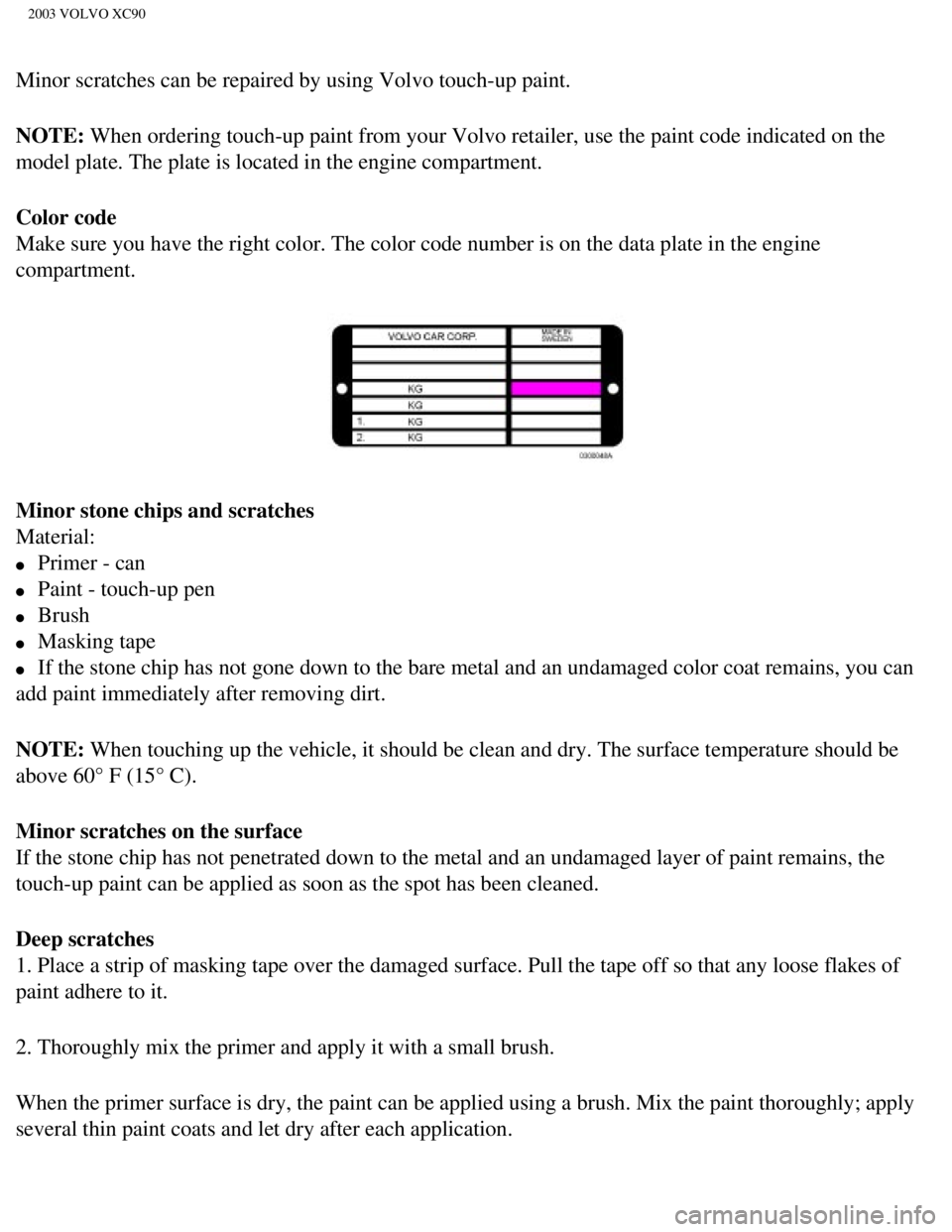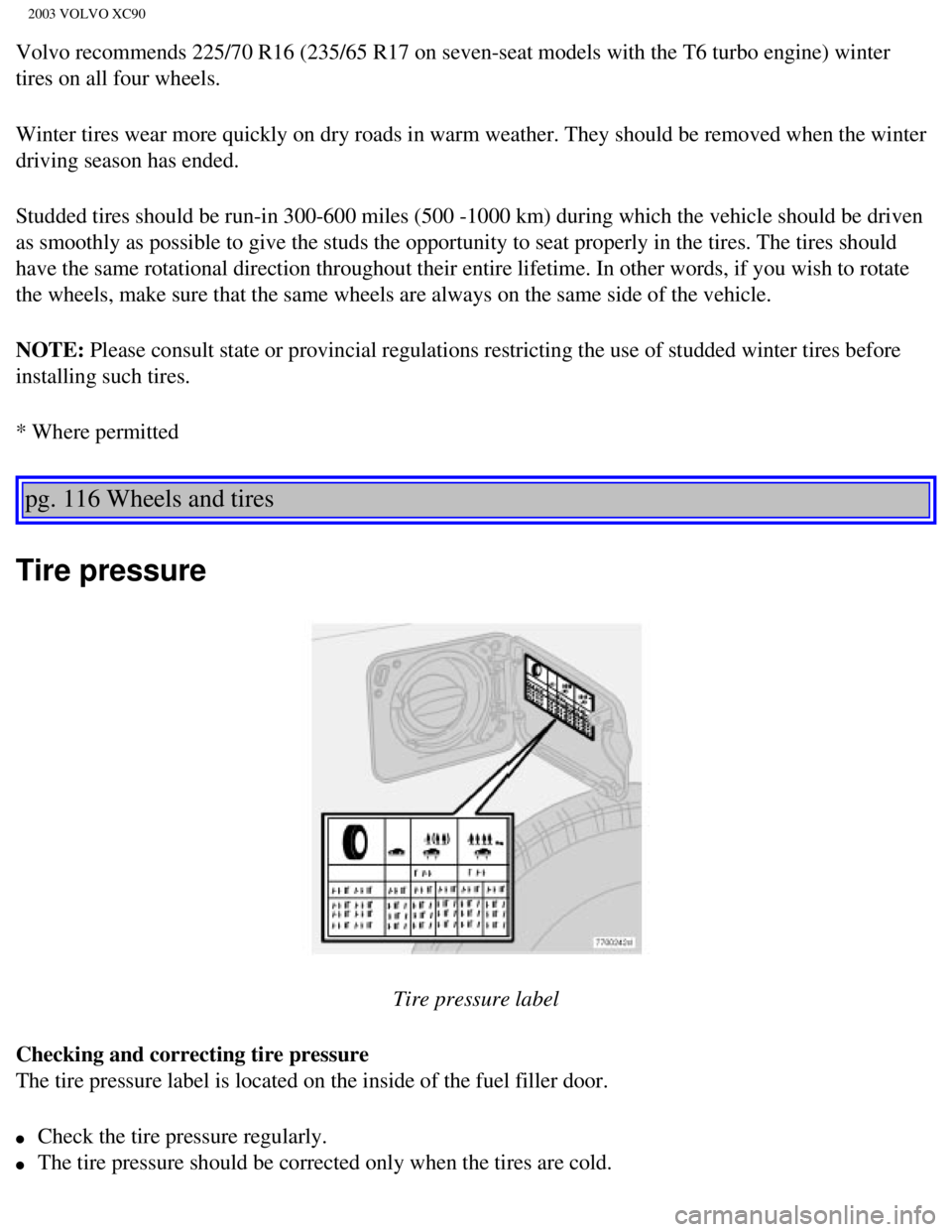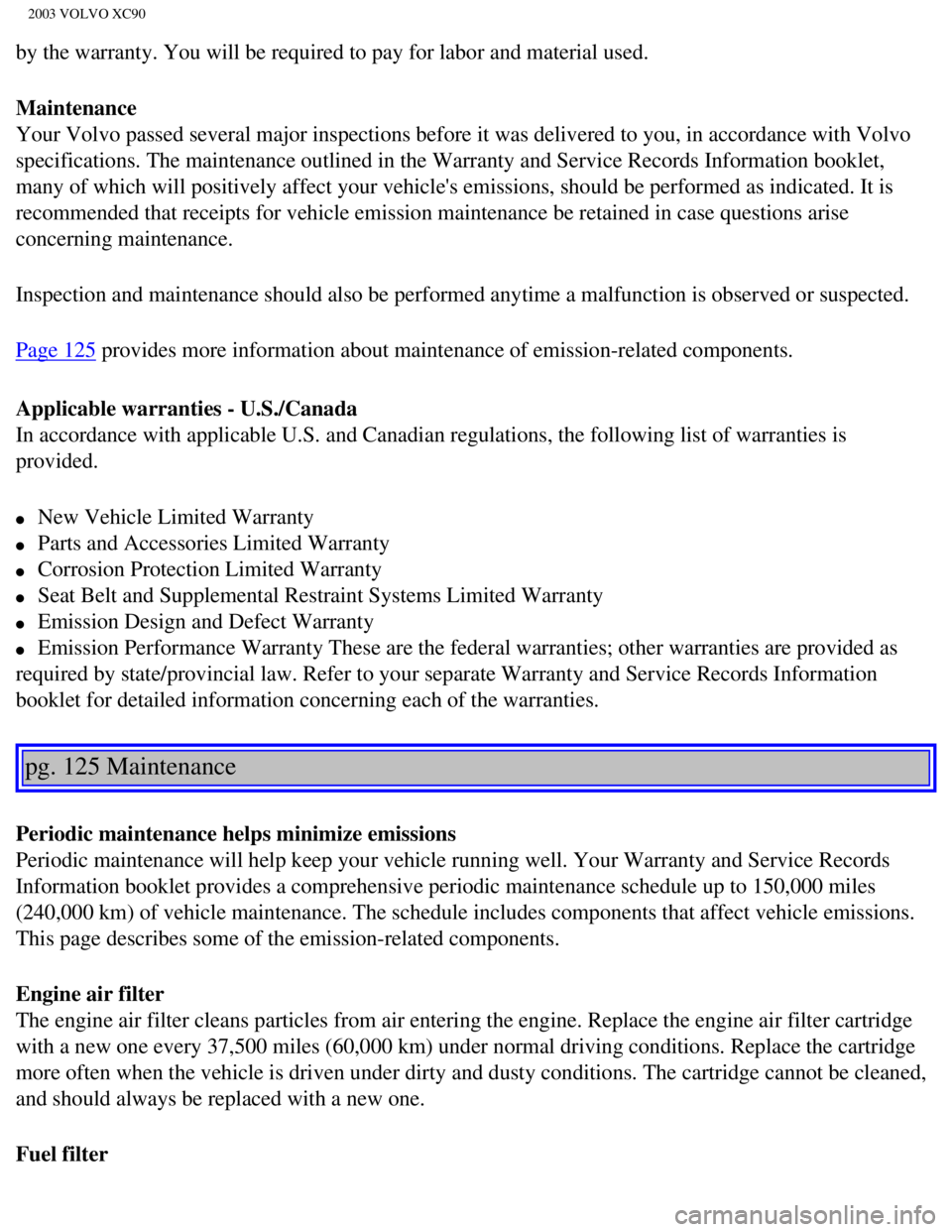2003 VOLVO XC90 engine
[x] Cancel search: enginePage 137 of 242

2003 VOLVO XC90
fl. oz. (8.5 cl) of detergent to 2.6 US gal. (10 liters) of warm wat\
er. After washing with a detergent the
vehicle should be well rinsed with clean water.
Bumpers: Wash the bumpers with the same cleaning agent used on the rest of the v\
ehicle. Never clean
the bumpers with gasoline or paint thinner. Difficult spots can be remov\
ed with denatured alcohol. To
avoid scratches, do not dry the bumpers with paper.
NOTE: When washing the vehicle, remember to remove dirt from the drain holes i\
n the doors and sills. CAUTION
- During high pressure washing, the spray mouthpiece must never be close\
r to the vehicle than
13" (30 cm). Do not spray into the locks.
- When washing or steam cleaning the engine, avoid spraying water or ste\
am directly on the electrical
components or toward the rear side of the engine.
Special moonroof cautions:
- Always close the moonroof and visor before washing your vehicle.
- Never use abrasive cleaning agents on the moonroof.
- Never use wax on the rubber seals around the moonroof.
WARNING!
When the vehicle is driven immediately after being washed, apply the bra\
kes several times in order to
remove any moisture from the brake linings.
Engine cleaning agents should not be used when the engine is warm. This \
constitutes a fire risk.
pg. 111 Vehicle care
Automatic washing - simple and quick
l We do NOT recommend washing your vehicle in an automatic wash during the\
first six months
(because the paint will not have hardened sufficiently).
l An automatic wash is a simple and quick way to clean your vehicle, but i\
t is worth remembering that
it may not be as thorough as when you yourself go over the vehicle with \
sponge and water. Keeping the
underbody clean is most important, especially in the winter. Some automa\
tic washers do not have
facilities for washing the underbody.
l Before driving into an automatic car wash, make sure that side view mirr\
ors, auxiliary lamps, etc, are
secure, and that any antenna(s) are retracted or removed. Otherwise th\
ere is risk of the machine
dislodging them.
Polishing and Waxing
l Normally, polishing is not required during the first year after delivery\
, however, waxing may be
file:///K|/ownersdocs/2003/2003_XC90/03xc90_07.htm (2 of 5)12/30/2006 \
4:19:00 PM
Page 139 of 242

2003 VOLVO XC90
Minor scratches can be repaired by using Volvo touch-up paint.
NOTE: When ordering touch-up paint from your Volvo retailer, use the paint cod\
e indicated on the
model plate. The plate is located in the engine compartment.
Color code
Make sure you have the right color. The color code number is on the data\
plate in the engine
compartment.
Minor stone chips and scratches
Material:
l Primer - can
l Paint - touch-up pen
l Brush
l Masking tape
l If the stone chip has not gone down to the bare metal and an undamaged c\
olor coat remains, you can
add paint immediately after removing dirt.
NOTE: When touching up the vehicle, it should be clean and dry. The surface te\
mperature should be
above 60° F (15° C).
Minor scratches on the surface
If the stone chip has not penetrated down to the metal and an undamaged \
layer of paint remains, the
touch-up paint can be applied as soon as the spot has been cleaned.
Deep scratches
1. Place a strip of masking tape over the damaged surface. Pull the tape\
off so that any loose flakes of
paint adhere to it.
2. Thoroughly mix the primer and apply it with a small brush.
When the primer surface is dry, the paint can be applied using a brush. \
Mix the paint thoroughly; apply
several thin paint coats and let dry after each application.
file:///K|/ownersdocs/2003/2003_XC90/03xc90_07.htm (4 of 5)12/30/2006 \
4:19:00 PM
Page 144 of 242

2003 VOLVO XC90
Volvo recommends 225/70 R16 (235/65 R17 on seven-seat models with the T\
6 turbo engine) winter
tires on all four wheels.
Winter tires wear more quickly on dry roads in warm weather. They should\
be removed when the winter
driving season has ended.
Studded tires should be run-in 300-600 miles (500 -1000 km) during whi\
ch the vehicle should be driven
as smoothly as possible to give the studs the opportunity to seat proper\
ly in the tires. The tires should
have the same rotational direction throughout their entire lifetime. In \
other words, if you wish to rotate
the wheels, make sure that the same wheels are always on the same side o\
f the vehicle.
NOTE: Please consult state or provincial regulations restricting the use of st\
udded winter tires before
installing such tires.
* Where permitted
pg. 116 Wheels and tires
Tire pressure
Tire pressure label
Checking and correcting tire pressure
The tire pressure label is located on the inside of the fuel filler door\
.
l Check the tire pressure regularly.
l The tire pressure should be corrected only when the tires are cold.
file:///K|/ownersdocs/2003/2003_XC90/03xc90_08.htm (4 of 12)12/30/2006\
4:19:01 PM
Page 153 of 242

2003 VOLVO XC90
2 0 0 3
VOLVO XC90
Maintenance
pg. 123 Maintenance
Volvo maintenance124
Working on your vehicle126
Engine compartment128
Oils and fluids129
Battery maintenance134
Bulbs137
Fuses145
pg. 124 Maintenance
Volvo Maintenance
Maintenance Volvo advises you to follow the maintenance program outlined\
in the Warranty and
Service Records Information booklet. This maintenance program contains i\
nspections and services
necessary for the proper function of your vehicle. The maintenance servi\
ces contain several checks
which require special instruments and tools and therefore must be perfor\
med by a qualified technician.
To keep your Volvo in top condition, specify time-tested and proven Genu\
ine Volvo Parts and
Accessories.
The Federal Clean Air Act - U.S.
The Federal Clean Air Act requires vehicle manufacturers to furnish writ\
ten instructions to the ultimate
purchaser to assure the proper servicing and function of the components \
that control emissions. These
services, which are listed in the "Warranty and Service Records Informat\
ion booklet," are not covered
file:///K|/ownersdocs/2003/2003_XC90/03xc90_09a.htm (1 of 15)12/30/200\
6 4:19:02 PM
Page 154 of 242

2003 VOLVO XC90
by the warranty. You will be required to pay for labor and material used\
.
Maintenance
Your Volvo passed several major inspections before it was delivered to y\
ou, in accordance with Volvo
specifications. The maintenance outlined in the Warranty and Service Rec\
ords Information booklet,
many of which will positively affect your vehicle's emissions, should be\
performed as indicated. It is
recommended that receipts for vehicle emission maintenance be retained i\
n case questions arise
concerning maintenance.
Inspection and maintenance should also be performed anytime a malfunctio\
n is observed or suspected.
Page 125 provides more information about maintenance of emission-related compone\
nts.
Applicable warranties - U.S./Canada
In accordance with applicable U.S. and Canadian regulations, the followi\
ng list of warranties is
provided.
l New Vehicle Limited Warranty
l Parts and Accessories Limited Warranty
l Corrosion Protection Limited Warranty
l Seat Belt and Supplemental Restraint Systems Limited Warranty
l Emission Design and Defect Warranty
l Emission Performance Warranty These are the federal warranties; other wa\
rranties are provided as
required by state/provincial law. Refer to your separate Warranty and Se\
rvice Records Information
booklet for detailed information concerning each of the warranties.
pg. 125 Maintenance
Periodic maintenance helps minimize emissions
Periodic maintenance will help keep your vehicle running well. Your Warr\
anty and Service Records
Information booklet provides a comprehensive periodic maintenance schedu\
le up to 150,000 miles
(240,000 km) of vehicle maintenance. The schedule includes components \
that affect vehicle emissions.
This page describes some of the emission-related components.
Engine air filter
The engine air filter cleans particles from air entering the engine. Rep\
lace the engine air filter cartridge
with a new one every 37,500 miles (60,000 km) under normal driving con\
ditions. Replace the cartridge
more often when the vehicle is driven under dirty and dusty conditions. \
The cartridge cannot be cleaned,
and should always be replaced with a new one.
Fuel filter
file:///K|/ownersdocs/2003/2003_XC90/03xc90_09a.htm (2 of 15)12/30/200\
6 4:19:02 PM
Page 155 of 242

2003 VOLVO XC90
The fuel filter should be replaced at 120,000 miles (193,000 km). The \
filter is replaced as a complete
unit. Replace more frequently if contaminated fuel is introduced into th\
e tank, or if there is reason to
suspect that this has occurred.
Fuel system, including filler cap, tank, lines, and connections
The ability of the fuel system to contain hydrocarbons depends upon a le\
ak-free system. Inspect fuel
lines every 30,000 miles (48,000 km). Check for proper sealing of the \
fuel filler cap, which contains "O"
ring seals.
NOTE: If the fuel filler cap is not closed tightly or if the engine is running\
when the vehicle is refueled,
the Check Engine light (Malfunction Indicator) may indicate a fault. H\
owever, your vehicle's
performance will not be affected. Use only Volvo original or approved fu\
el filler caps.
Timing belt
For proper functioning of the engine and emission control systems, the t\
iming belt and belt pretensioner
must be replaced every 120,000 miles (193,000 km). Engine damage will \
occur if the belt fails.
PCV system
(on turbocharged models)
The nipple in the intake manifold and the filter at the end of the PCV h\
ose in the air cleaner should be
inspected and cleaned at 120,000 miles (193,000 km), and again at 150,\
000 miles (240,000 km).
Spark plugs
The spark plugs should be replaced every 60,000 miles (96,000 km) unde\
r normal driving conditions.
City driving or fast highway driving may necessitate replacement sooner.\
Under normal driving conditions, spark plugs require no maintenance betw\
een replacement intervals.
When installing new plugs, be sure to use the right type and to tighten \
them correctly. When changing
the plugs, clean the terminals and rubber seals. Also check that the sup\
pressor connectors are in good
condition. Cracked or damaged connectors should be replaced.
pg. 126 Maintenance
file:///K|/ownersdocs/2003/2003_XC90/03xc90_09a.htm (3 of 15)12/30/200\
6 4:19:02 PM
Page 156 of 242

2003 VOLVO XC90
Reinforced lifting points
Working you your vehicle
Hoisting the vehicle
If a garage jack is used to lift the vehicle, the two jack attachments p\
oints should be used. They are
specially reinforced to bear the weight of the vehicle (see the illustr\
ation above). A garage jack can also
be placed under the front of the engine support frame. Take care not to \
damage the splash guard under
the engine. Ensure that the jack is positioned so that the vehicle canno\
t slide off it. Always use axle
stands or similar structures. The car's gross vehicle weight is between \
5770 lb (2630 kg) and 6080 lb
(2760 kg). Use a jack and stands rated for this weight.
If a two-post hoist is used to lift the vehicle, the front and rear lift\
arm pads should be centered under the
reinforced lift plates on the inboard edge of the sill rail (see illust\
ration).
Please note the following before you begin working on your vehicle:
Battery (see also
page 136 for more information on handling the battery)
l Ensure that the battery cables are correctly connected and tightened.
l Never disconnect the battery when the engine is running (e.g. when repl\
acing the battery).
l The battery contains acid that is both corrosive and poisonous. It is im\
portant that the battery is
handled in an environmentally friendly way. Let your Volvo retailer assi\
st you.
l Never use a fast charger to charge the battery. The battery cables shoul\
d be disconnected when
recharging.
file:///K|/ownersdocs/2003/2003_XC90/03xc90_09a.htm (4 of 15)12/30/200\
6 4:19:02 PM
Page 157 of 242

2003 VOLVO XC90
WARNING!
The ignition system has very high voltage! The voltage in the ignition s\
ystem is dangerous!
Do not touch spark plugs, ignition cables or the ignition coil when the \
engine is running or the
ignition is switched on!
The ignition should be switched off when:
- Conducting engine tests.
- Replacing parts in the ignition system, such as spark plugs, ignition \
coil, distributor, ignition cables,
etc.
- Never try to repair any part of the SRS/ SIPS/WHIPS/IC systems yoursel\
f. Any interference in the
system could cause malfunction and serious injury. Any work should only \
be performed by an
authorized Volvo workshop.
pg. 127 Maintenance
Belt check
Check the belt regularly to make sure it is in good condition and is cle\
an. A worn or dirty belt can cause
poor cooling and low alternator output as well as impair the operation o\
f the power steering and the air
conditioning unit.
NOTE: The drive belt is equipped with a self-tensioning mechanism and requires\
no adjustment
between changes.
WARNING!
The engine must not be running when this check is
performed.
Check coolant level
The cooling system must be filled with coolant and not leak to operate a\
t maximum efficiency. Check
the coolant level regularly. The level should be between the "MAX" and "\
MIN" marks on the expansion
tank. The check should be made with particular thoroughness when the eng\
ine is new or when the
cooling system has been drained.
Do not remove the filler cap other than for topping up with coolant. Fre\
quent removal may prevent
coolant circulation between the engine and the expansion tank during eng\
ine warm up and cooling.
Changing coolant
file:///K|/ownersdocs/2003/2003_XC90/03xc90_09a.htm (5 of 15)12/30/200\
6 4:19:02 PM